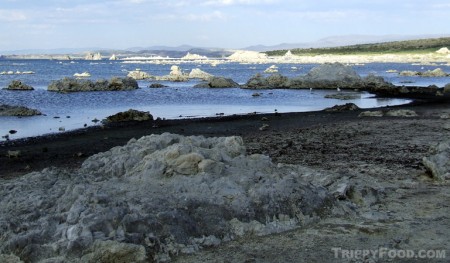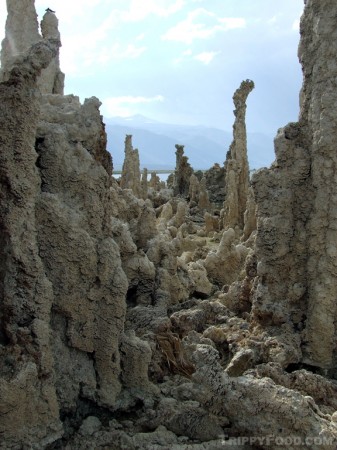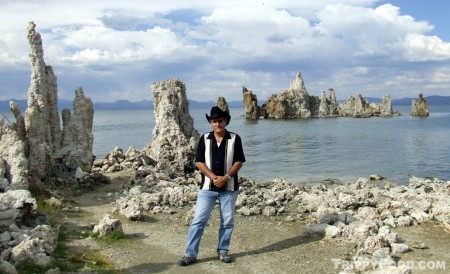Mono Lake
Mono County, California
Mono Lake (pronounced like Sonny Bono, not like U2’s Bono) in California’s Eastern Sierra Mountains was formed over three-quarters of a million years ago, making it one of the oldest lakes in North America. Even at its respectable 65 square mile coverage, in its heyday it may have been close to 1,000 feet deep. Its desert surroundings once prompted author Mark Twain to call Mono Lake the loneliest place on earth, but its stark beauty brings visitors worldwide. A big part of the lake’s attraction can be found at Mono Lake Tufa State Natural Reserve at the south end, where calcium carbonate tufas rise from the shoreline and former lake bottom like Silly Sand towers. These natural formations look like dead coral, but were created from a bubbling up of minerals from a mixture of the cold waters running into the lake and sinking to the bottom reacting with the naturally alkaline water. The sad fact is that all the exposed tufas had been formed completely under water. In 1913, water diverted from nearby Owens Lake via the Owens River into the Los Angeles Aqueduct to help Angelenos 350 miles to the south transform their desert into a lush paradise. The devastating result is that today Owens Lake is a dead, dry lake bed. In order to supply Los Angeles’ hydrogen dioxide habit, Los Angeles Department of Water and Power started shaking down the rivers and streams that fed Mono Lake starting in 1941. The junkies depleted so much of the water from the lake that the volume has been halved and the lake level has been reduced by over 45 feet, exposing the tufa towers. As beautiful as the now-exposed towers are, the loss of water has critically impacted the lake’s fragile ecosystem. The lake features two islands, the larger Paoha and smaller Negit Island, located near the lake’s north shore. For hundreds of years since volcanic Negit Island last erupted it has served as the second largest nesting grounds for California gulls in North America, but with the recession of the water level a land bridge was formed that allowed predators such as coyotes to devastate the nesting population.
In 1994, the California State Water Resources Control Board performed an intervention and reduced the amount of water Los Angeles could divert, demanding that the water level be increased in the lake close to the 1941 level. The lake level is already back up high enough to submerge the land bridge to Negit Island, but the tufas are still exposed; in the next few decades, for the benefit of the lake, they may once again dwell beneath the waters. In addition to the tufa towers, there are other fascinating aspects of Mono Lake to take in. Besides the California gull nesting population, the lake also attracts American avocets, killdeer, sandpipers, eared grebes, snowy plovers and Wilson’s and red-necked phalaropes who either nest there or just stop by passing through. Occasionally ospreys can be seen perched on the tufas, but the alkaline and hypersaline water does not support the fish that they eat (efforts to stock the lake have resulted in dismal failure). About the only two things that do live in the water are algae, and the voracious, algae-eating Mono Lake brine shrimp. This tiny species of shrimp is found only in Mono Lake by the billions, itself being a food source for the migrating birds. Another of the lake’s inhabitants that will liven up your visit are the Alkali or Brine Fly (Ephydra hians). These flies hug the shore in a black carpet millions thick; they also eat the algae in the lake and form bubbles which they use to submerge and maneuver in the shallows. Not only do these flies not bite, but they have an eerie habit of avoiding contact with people – they part like Lost’s smoke monster with millions of tiny wings creating an audible hum. It takes some getting used to walking through them, but once you become accustomed to the fact that they want nothing to do with you, the parting of the black sea becomes pretty cool. The pupae of this fly were collected by the local Paiute (Kutzadika’a) tribe for food, which gave the lake and the area its name (“mono” is “fly-eaters” in their indigenous language).
A trail from the park entrance winds down past the temporarily land-locked tufas and around the towers along the shore. Bring along a copy of Pink Floyd’s “Wish You Were Here”; in 1974, Storm Thorgerson took a photograph here entitled, “The Diver” which was featured on the inside album art. In the photo, a man appears to be diving into the lake with the tufas in the background, yet there are no ripples in the water. To create the illusion of a dive with no splash or ripples, the diver did a still handstand underwater in an effort to demonstrate absence (a theme found throughout the album). Being a natural environment there is a strong possibility that the tufas in the background have changed size and shape since 1974, but it’s fun to try to find the spot where the photo was taken. This area also provided the backdrop for metal band Cinderella’s video for the song “Don’t Know What You Got (Till It’s Gone).” Mono Lake is relatively close to Bodie Ghost Town, Yosemite National Park, Devil’s Postpile and other attractions in the High Sierras making it a welcome diversion if you’re in the area. Since the effort to raise the lake level is well underway, don’t delay in visiting the site or your journey to see the tufas could leave you high and dry.
Mono Lake South Tufa Trail
Test Station Road
Mono South, CA 93541
GPS Coordinates: 37°56’19.70″N 119°1’37.42″W





That place looks awesome. I wouldn’t mind showing up at dawn or dusk and taking pictures there.
They say just before dusk and after dawn in the winter is spectacular, especially if there’s a dusting of snow. I’ve been there twice and it took on a different personality each time.
The magic hour! Diffusing light makes everything impressive.
The tufa formations are amazing. Man, I’ve been wanting to travel for years but still can’t afford it. When I am able to afford it, I will certainly consider going to this part of the country (I already wanted to, but now I have one more spot to visit, thanks to you).
Jeremy, if you decide to go it should be sooner than later – in a few years the formations will be underwater again.